-
Posts
4,419 -
Joined
-
Last visited
-
Days Won
16
Content Type
Profiles
Forums
Events
Store
Posts posted by Evan Burton
-
-
-
All he has to do is produce a photo of ANY LRV ON ANY APOLLO MISSION WHICH IS ATTACHED IN POSITION ON THE OUTSIDE OF A LUNAR MODULE...

Apollo 15 - Image KSC-71PC-415

Apollo 16 - AS16-118-18894
Crop of AS16-118-11894HR
Crop of AS17-151-23201HR
Crop of AS17-151-23204HR
I cannot locate such photos from any of the three missions. I must have missed them. Please give me the file numbers so I can look at them. When I see them, I will admit being mistaken.
Jack
Yeah, sure you will.
-
I'm guessing that's a NO then......

-
Notice how Jack tries to change the subject, move the goalposts, gish-gallop, in fact anything except admit he was wrong.
He sits there arguing that black is white and fails to see why people realise he is incompetent with respect to Apollo.
-
Lastly, let's compare all the MESAs.
What you have there is, from left to right, the Apollo 11 training LM (S69-31585), the Apollo 17 LM (AS17-140-21370), the Apollo 12 MESA (AS12-46-6725) and the Apollo 16 MESA (AS16-116-18578). All images cropped.
Notice how they all show the same thing. Have a look at the Apollo 11 MESA:
(AS11-40-5873, cropped and annotated)
Again - if Jack is right, why do all these images show the same thing... yet Apollo 11 through 14 did not carry LRVs?
Simple - because Jack is wrong.
-
Lets have a look pre-flight, during the loading of the LRV onto the descent stage.
(KSC-71PC-346, cropped and annotated)
So we have now confirmed that the LRV was mounted where I claim, and not where Jack claims.
Will Jack admit he is wrong? I doubt it.
Kathleen, that is why you cannot rely on Jack's Apollo claims - they are riddled with errors and he refuses to admit them.
-
Kathleen,
I hope you are following this because it is a classic example of why Jack cannot be trusted with respect to his Apollo claims, why his claims lack any substance whatsoever.
Notice there are no image numbers. Jack doesn't like to provide image numbers, because that allows you to check his claims using better quality, high resolution images rather than the poor quality crops he spoon feeds you. If he alters them, you'll be able to see that. Once you can independently check claims, he loses his control over you.
So - has Jack been able to provide any evidence for his claims?
Has he been able to show any diagramme, any image, any manual, any text, anything at all that supports his claims that the LRV is on the left (when looking from outside the LM, standing in front of the ladder)?
NO.
Has he been able to show any diagramme, any image, any manual, any text, anything at all that has the LRV package being covered with any type of covering or thermal blanket?
NO.
Anyway, now let's see about my claims. I have previously shown multiple diagrammes and images showing the MESA in Quad IV and the LRV in Quad I, exactly the opposite to what Jack claims.
I have previously shown multiple images showing the MESA with a thermal blanket on it.
I have previously shown multiple images showing the LRV did not have any such covering.
Now let's have a closer look, and compare the two LM quads: MESA down, and LRV already deployed. The base images to use are those Jack has referred to in his previous post. Because he didn't label them, I'll give you the correct image number. Ensure that the images correspond to what you are expecting to see, in case I have made a mistake.
The left hand side of the post Jack made is a crop from AS17-140-21370. On the top-right, is another crop from the same image. The bottom-right is a crop from AS16-116-18578. That, by the way, is from an entirely different mission... something Jack "forgot" to mention.
Let's start with AS17-140-21370, and look at where I claim the LRV would have been stowed. I'm going to use the high resolution version, so we can more detail. Have a look at the bottom of the LM's descent stage - there is a white frame hanging down, as shown below.
(AS17-140-21370, cropped and annotated)
Let's also have a look at the same position on the other image Jack used, AS16-116-18578:
(AS16-116-18578, cropped and annotated)
Now, let's have a look at an earlier graphic I provided of the LRV deployment sequence.
From yet another graphic of the LRV deployment.
Yet more!
We have seen that bracket on the Apollo 16 and Apollo 17 images - but what about Apollo 15? My next post will answer that.
-
My guess it could be due the frustration of getting so close to the Moon but never walking on it or due to his life being anti-climatic after 1969 or it could have nothing to do with his involvement in Apollo.
I'm not so sure about that. IIRC, he was offered command of a later mission (if the rotation held, it would have been Apollo 17) but turned it down. The constant training, preparation, etc, had worn him down. I believe he felt it was taking too great a toll on his home life, and wanted to return to a more regular life and patch up whatever cracks were starting to appear in his marriage.
-

No white covering.
-
You have been show this and had it explained several times, but it seems you are incapable of learning - or admitting error.
The image shows Quad IV with the MESA (Modularised Equipment Stowage Area). The white "sheet" is a thermal blanket, covering over the MESA... which the LRV did NOT have. Here is the MESA:

This one has a gold mylar covering; the later J series missions (of which Jack shows) had a white covering.
Look back over the images of the LRV - where does it have a covering? Nowhere - because it didn't have one.

On the other hand, there are a couple of struts that were used to lower the LRV. Look at the image Jack has shown where the LRV was, and what do you see? The struts hanging down.
-
There is a news conference held in some auditorium with the 3 men sitting stone-faced on a dais: Buzz Aldrin, Neil Armstrong and Michael Collins. I've never seen such crest-fallen people in my life. You have to watch it to believe it. Collins accidentally remarked about his falling over the TV cables. One of the other astronauts starts to speak and mentions the "scientific camera," as a cover for Collins. They sit there like they're in a trance. So what I'm saying is, who can you believe? And that's why I asked my "ignorant" questions.
That's because they were tired. Do know that after the landing they visited 25 different countries in 35 days? How many states within those countries did they visit? And how many functions do you think they did per day?
On youtube.com there is a sequence of videos claiming the moon walk was a hoax perpetrated by Nixon and filmed by film director Kubrick, who afterwards became a recluse. Kissinger, Nixon's first secretary, Alexander Haig and others around Nixon at that time said he wanted to put a man on the moon in '69 (ater he took office). NASA wasn't ready. I believe, if Nixon faked this, it was a private ode to President Kennedy who said we'd have a man on the moon by the end of this decade (1969).
Kathy C
I thought my post here disappeared by some technicality. So I posted this post (basically the same) twice. Sorry.
That clip is from a mockumentry called "Dark Side of the Moon" - it's fiction, made up to poke fun at the moon hoaxers... and show how gullible they can be with something that appears to support their views. If you watch the whole thing, you'll see character names from various Kubrik films appearing all over the place, sometimes mixed together (e.g. Dimiti Muffley - Russian Premier Dimitri Kissoff, and President Merkin Muffley, from Dr Strangelove).
-
-
-
Todd is resorting to fiction again. Officially, the rovers were stowed outside the LMs, just to port of the descent ladder.
But there are NO PHOTOS showing this. If I ever said anything about carrying a LM down the ladder, I may have been
trying to make a joke...since no believable photos exist of the "stowed" LM.
Jack
No Jack - you have been told over and over again, but you refuse to admit you were wrong. Officially, in every single photograph (of which there are many) and in every piece of documentation, the LRV was stowed in Quad 1 of the LM's descent stage.

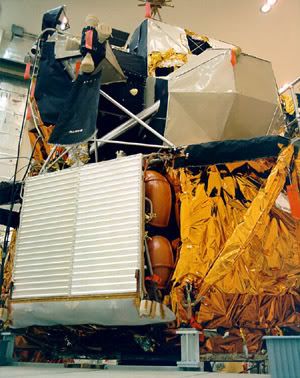
Just because YOU say differently, and have not one shred of evidence to back your claim, will not change reality. Facts are stubborn things.
-
In such low gravity on the moon or floating in their space capsules, how do astronauts keep their food down?
Kathy C
That is an excellent question
First, let's talk about the food. It was carefully selected and prepared. To begin with, it was preferred if the food was 'low residue', meaning they didn't have to poop so often (a very unpleasant experience in a spacecraft). Next, it had to be able to be stored without any refrigeration (no icebox in the spacecraft!). Of course, it had to provide necessary vitamins and minerals needed by the astronauts - the moonwalkers especially, who expended a great deal of energy during their EVAs. And, of course, you had to be able to eat it in low / no gravity conditions. Lastly, it was highly desirable for it to take up as least amount of volume as possible, and weigh as least as possible; space was at a premium inside the spacecraft, and keeping the weight down was critical.
When the first manned space flights started, they experimented with various types: cubes of freeze-dried food, meals turned into a paste and put in a tube, etc. Obviously a prime concern was not to be a messy eater - crumbs or flakes floating around the spacecraft could short out electrical equipment or cause other damage. There was also concern that an astronaut would not be able to actually eat in microgravity; John Glenn and others showed that this was not a issue. Once the astronaut could get food into their mouth, eating and swallowing was as per normal.
(As you are no doubt aware, swallowing doesn't rely on gravity - the oesophagus actually 'kneads' the masticated food down into the stomach)
What was a problem though was taste - the food was not appetising, and was at times downright horrible. As experience in spaceflight was gained, things improved. They mixed gelatin in with some foods so it wouldn't form crumbs. Dehydrated food was placed in plastic bags with a nozzle; water could be injected (on Apollo, they had hot water), the contents mixed by squeezing and then squeezed out of the packet into the mouth.
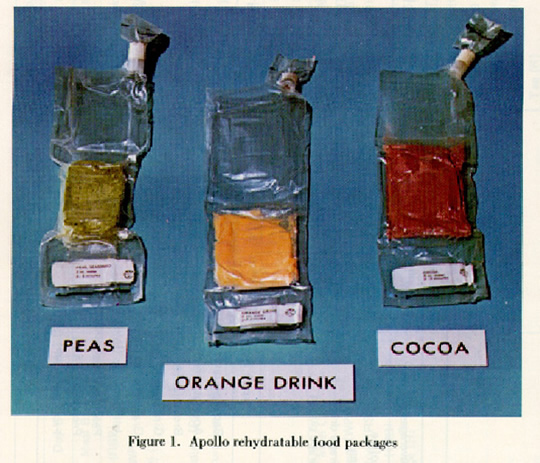
Most importantly it started tasting better. They also came up with 'spoon bowl' meals. When the contents were re-hydrated, the moisture content allowed the contents to become sticky and be eaten with a spoon.
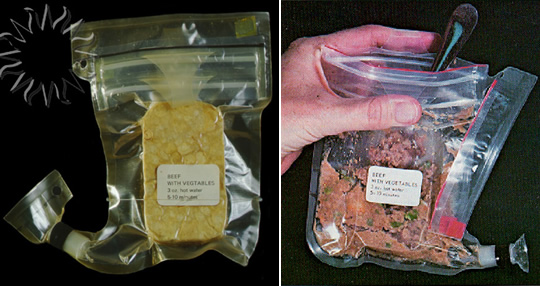
The astronauts were now able to select what foods they wanted to eat. Al Bean (Apollo 12) was said to have loved spaghetti. Here is the menu for his fellow moonwalker, Pete Conrad:
If you are really interested, you can read all about the development of the 'food systems' here (PDF document).
-
This is indeed a disaster but you still have to remember:
This plant was about to be retired because it no longer met standards. It suffered through a huge earthquake and then a tsunami, and yet still didn't have a 'catastrophic' failure. The failure it is going through now is being caused by more than the 'worst case scenario': loss of power, loss of diesel generators, damage to water intakes, no backup power supplies, etc. And while I would indeed question the wisdom of placing nuclear power plants in a country / area that is guaranteed to be subjected to massive earthquakes, there are a multitude of other nuclear power plants in Japan that were closer / suffered the same forces and still successfully - and safely - shut down.

Nuclear power plants in Japan
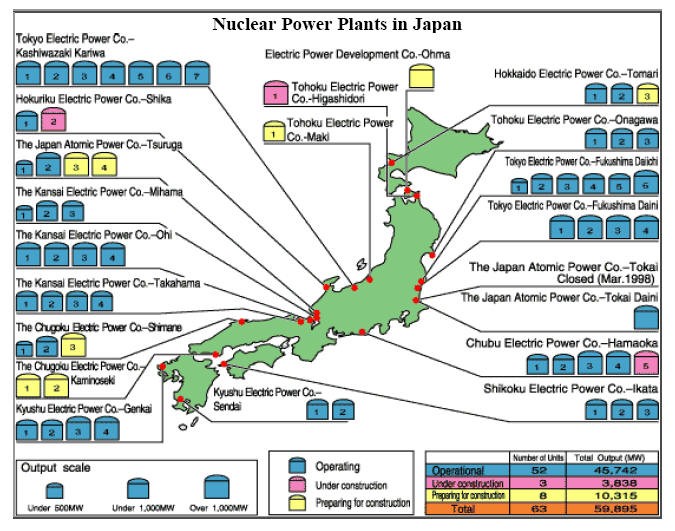
-
Kathleen,
You might not be aware that spacecraft in Earth orbit sometimes pass through the Van Allen belts (a portion known as the South Atlantic Anomaly).
This means that astronauts aboard Skylab, the Shuttle, and the ISS can actually get higher doses than that of the Apollo astronauts because they are continually being exposed to it. Have a look at this chart:
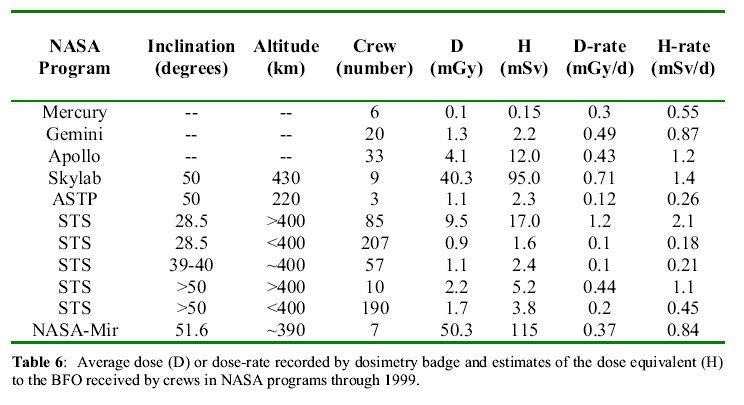
-
I couldn't find a moon walk thread here because it was everybody fighting. But I have questions. Maybe Jack White could answer.
First Moon Walk
How did we get through the Van Allen Radiation Belts?
Why is it that when the astronauts were on the moon there was gravity. On youtube.com you can see them jumping, not "flying." Often we were shown how lack of gravity made the astronauts in their capsule float freely in the air. Why didn't we see this on the first moon walk?
Also, if there's no gravity, how could they stay on the moon? Wouldn't they fly off into space? And the rocket too?
Thank You,
Kathy C
Hi Kathleen!
1. The Van Allen belts. These were traversed by the spacecraft having a sufficient layer of shielding, by travelling through the areas of least radiation density, and by getting through the belts as quickly as possible. Some details can be seen in the Apollo radiation plan and the biomedical results from Apollo. Some good summaries are also available here and here, where you can calculate yourself the anticipated dosage based on the flight plans. These diagrammes might help you understand how they skirted the VAB:


2. Gravity. The Moon, being quite a small solar body, has quite low gravity (approximately 1/6th that of the Earth). If you want to work it out for yourself, use the formula:
g = -GM/(r*r)
where :
g is the acceleration of gravity at a particular point. On the surface of the Earth, g is approximately 9.81 m/s2
G is the universal gravitational constant = 6.67x10-11 Nm2/kg2
M is the mass of the object. Look up the mass of the Moon yourself. Make sure the mass is expressed in Kg.
r is the distance from the centre of the body, in metres. In other words, the radius of the body. Again, look that up yourself.
The negative sign is used to reflect the fact that the pull of gravity is toward the centre. To compare it to the acceleration due to gravity on Earth, compare to 9.81
Anyway, low gravity does not mean NO gravity. When you see footage of the Apollo astronauts floating around the spacecraft, that is in space (technically called microgravity). On the Moon, you could see the effects of the low gravity:
- Dust and dirt arcing, following a ballistic trajectory but showing no signs of billowing (which would happen in an atmosphere)
- Astronauts able to leap around, jumping quite high despite having significant mass on them from their suits and life support system - the PLSS (they didn't jump as high as they might have been able to for two reasons: firstly, the suit restricted their movements; secondly, they were worried about losing their balance and damaging the PLSS or helmet).
- Difficulty in drilling for core samples in the lunar crust; they couldn't rely on weight to keep them down. Leaning on the drills only had minimal effect because they weighed so much less.
Happy to answer further questions, or expand on any of the answers if you like.
-
The difference between contrails and chemtrails is that contrails EVAPORATE and chemtrails turn into clouds.
Jack
Perfectly highlighting your ignorance; the environmental conditions of the atmosphere have everything to do with contrails and their persistence, not a simple black & white situation you laughingly proclaim above. You are uninformed on this subject and should learn more about it before trying to voice opinions. There are a multitude of online resources regarding basic meteorology; I suggest you utilise them.
Edited to add: you need to re-read this post I made, which contains an article written by a TRAINED METEOROLOGIST.
http://educationforum.ipbhost.com/index.php?showtopic=15977&view=findpost&p=213639
-
Clouds do not suddenly appear in a blue sky without cause.
And it is called weather, Jack. Since you seem to know little about it, here is a primer:

How do clouds form?
Clouds are possibly the most interesting -- and beautiful -- of all weather phenomena. While there are a wide variety of cloud shapes and sizes, they are all made of the same thing: condensed water or ice. Clouds form when rising air, through expansion, cools to the point where some of the water vapor molecules "clump together" faster than they are torn apart by their thermal energy. Some of that (invisible) water vapor condenses to form (visible) cloud droplets or ice crystals.
The cloud example pictured above is considered "convective", because it is produced from warm air pockets rising directly ("convecting") from the underlying surface. Convective clouds are typically smaller, a hundred yards to several miles across.
"Stratiform" clouds, in contrast, typically cover much larger areas and are caused by much broader layers of more slowly rising air (see below), often associated with extratropical cyclone activity. Stratiform clouds have a more uniform, featureless appearance, and often cover the whole sky.
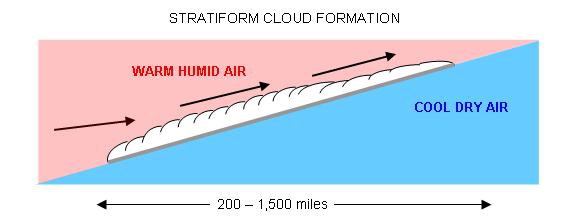
Some different types of clouds can be seen here.
After cloud droplets (or ice crystals) form, then what happens to them? One of two things. Either they collide with each other and grow by joining together to such a large size that they fall to the ground as rain or snow, or they evaporate and change back into water vapor. It is estimated that, on average, about one-half of all cloud material in precipitation systems eventually falls to the Earth as precipitation, while the other half re-evaporates back into water vapor.
-
Burton not only denies the existance of chemtrails, but also denies the fact that chemtrails can can morph into clouds.. The pictures prove him wrong.
You're the one who is wrong, Duane (gee - what a surprise). Perhaps you missed where I said:
I have no idea whether or not these "clouds" contain chemicals.
They do, in fact. There is residue from fuel / combustion so they do contain chemicals... but they are not, in general, the "chemtrails" as people claim. So in fact we have a couple of points:
- Ordinary contrails do contain chemicals when formed by the combustion process from a jet engine.
- Chemical spray is a known process, so it is possible to have chemical trails laid by aircraft (I'll mention this later).
Of course there can be such things as chemtrails; it's just that everything Jack and yourself provide as "proof"TM can more simply be explained as natural weather phenomena, and you both always fail to back up your claims with any rigorous scientific examination.
-
Cores still intact, nuclear experts say
Australian experts have urged calm over Japan's nuclear crisis, saying none of the protected nuclear cores within the damaged plants appear to have been breached.References to a meltdown of Chernobyl-like proportions were also unhelpful, they said, because the Japanese plants were of a fundamentally different design to those hit by the 1986 disaster.
This meant the mistakes that had led to the Ukrainian crisis could not be repeated.
"What's the worst consequence that could happen? Well, my view is that words like meltdown are not helpful," Australia's John Price, a former member of the safety policy unit of the UK's National Nuclear Corporation and now a consultant, told a news conference on Tuesday.
"Once the shutdown occurred, even on the first day, we were really not talking about meltdown ... what we're talking about is overheating and damage of the cladding of the core.
"(And) at the moment, the fundamental nuclear protection hasn't been violated at any of these reactors."
Dr Price said about 14 nuclear plants were involved in the Japanese emergency, most of which had gone through a graduated shutdown and were now safely under control, although there was continuing trouble at three plants (Fukushima Daiichi Units 1-3).
All were boiling water reactors - meaning they produce steam that turned a turbine - and he said even when their nuclear reaction was switched off it took "days, weeks and months" for this heat to dissipate.
He said the plants in most trouble had experienced a major failure of their inbuilt cooling systems - the result of earthquake damage and power outages - and so seawater was being pumped on to the core in an continuing and makeshift cooling effort.
Dr Price said one plant - unit 2 - was of most concern because the seawater may not be sufficiently reaching and therefore cooling it.
Should there be an explosion, though, several layers of containment are built into the plant's design.
This was in contrast to Chernobyl, where the Soviet-built facility had no such mechanisms. When an operator error triggered an explosion, radioactive material was blown into the atmosphere.
Dr Price was joined by Associate Professor Gerald Laurence, a radiation safety consultant to Adelaide and Flinders universities, and Peter Burns, former chief executive of the Australian Radiation Protection and Nuclear Safety Agency.
"If it very difficult to assess the potential hazzard," Dr Laurence said.
"However, what information we do have suggests that it is far from being the same sort of excursion that occurred at Chernobyl over 20 years ago, and indeed that would have been unlikely given the very different model of reactor."
Dr Burns said the explosions and fires at the damaged plants would have released some radioactive gases - likely iodine 131 and cesium 137 - although the "consequences of those are not as great as if some of the more potent fission products from the fuel were released".
"Questions revolve around (whether) the primary containment vessels have been breached or are they intact? and it would appear that they are all intact at the moment," Dr Burns said.
He also said continuing monitoring of background radioactivity levels in Australia showed no abnormalities, although even the Chernobyl disaster was not of a scale to register here.
-
This is interesting: from the MIT Nuclear Science and Engineering information hub.
Why I am not worried about Japan’s nuclear reactors
By Dr Josef Oehmen
**********
This article refers mainly to the events of the Daiichi-1 reactor. The developments at Daiichi-3 seem to take a parallel course today. The explanations in this document will help you understand what is going on there as well. Stay informed at http://www.world-nuclear-news.org/RS_Venting_at_Fukushima_Daiichi_3_1303111.html
It is also save. “Nuclear meltdown” sells papers. It is the same quality of agitative journalism that far right wing parties resort to when they try to tell you that all immigrants are lazy criminals.
**Update**
If you wish to share this information, please link to this article. This is the place where Josef will (if he does) post any updates or direct you to the latest version.
**Update**
I have to stop moderating the comments as my parents in law have come over to stay with us due to the fear of aftershocks, so I am sorry if that causes any inconvenience, or stifles any debate. I honestly didn’t expect this level of interest (its over 32,000 views as of 11:12pm Japan time)
Just a few comments. I do not work for the nuclear industry. I am an English teacher, from Australia, living in Kawasaki, Japan. My friend Dr J. Oehmen is a family member, and by far and away the most intelligent person I know. Feel free to believe/disbelieve whatever we have written. There are no conspiracies, however if you need to, feel free to make some up. They are quite entertaining.
Japanese readers, I hope your family and loved ones are safe, everyone else, no matter what you believe stay safe.
Morgsatlarge.
**original post below**
I know this is a fairly full on statement from someone posting his very first blog. It will also be far and away the most well written, intelligent post I ever make (I hope!) It also means I am not responsible for its content.
This post is by Dr Josef Oehmen, a research scientist at MIT, in Boston.
He is a PhD Scientist, whose father has extensive experience in Germany’s nuclear industry. I asked him to write this information to my family in Australia, who were being made sick with worry by the media reports coming from Japan. I am republishing it with his permission.
It is a few hours old, so if any information is out of date, blame me for the delay in getting it published.
This is his text in full and unedited. It is very long, so get comfy.
*********
We will have to cover some fundamentals, before we get into what is going on.
Construction of the Fukushima nuclear power plants
The plants at Fukushima are Boiling Water Reactors (BWR for short). A BWR produces electricity by boiling water, and spinning a a turbine with that steam. The nuclear fuel heats water, the water boils and creates steam, the steam then drives turbines that create the electricity, and the steam is then cooled and condensed back to water, and the water returns to be heated by the nuclear fuel. The reactor operates at about 285 °C.
The nuclear fuel is uranium oxide. Uranium oxide is a ceramic with a very high melting point of about 2800 °C. The fuel is manufactured in pellets (cylinders that are about 1 cm tall and 1 com in diameter). These pellets are then put into a long tube made of Zircaloy (an alloy of zirconium) with a failure temperature of 1200 °C (caused by the auto-catalytic oxidation of water), and sealed tight. This tube is called a fuel rod. These fuel rods are then put together to form assemblies, of which several hundred make up the reactor core.
The solid fuel pellet (a ceramic oxide matrix) is the first barrier that retains many of the radioactive fission products produced by the fission process. The Zircaloy casing is the second barrier to release that separates the radioactive fuel from the rest of the reactor.
The core is then placed in the pressure vessel. The pressure vessel is a thick steel vessel that operates at a pressure of about 7 MPa (~1000 psi), and is designed to withstand the high pressures that may occur during an accident. The pressure vessel is the third barrier to radioactive material release.
The entire primary loop of the nuclear reactor – the pressure vessel, pipes, and pumps that contain the coolant (water) – are housed in the containment structure. This structure is the fourth barrier to radioactive material release. The containment structure is a hermetically (air tight) sealed, very thick structure made of steel and concrete. This structure is designed, built and tested for one single purpose: To contain, indefinitely, a complete core meltdown. To aid in this purpose, a large, thick concrete structure is poured around the containment structure and is referred to as the secondary containment.
Both the main containment structure and the secondary containment structure are housed in the reactor building. The reactor building is an outer shell that is supposed to keep the weather out, but nothing in. (this is the part that was damaged in the explosions, but more to that later).
Fundamentals of nuclear reactions
The uranium fuel generates heat by neutron-induced nuclear fission. Uranium atoms are split into lighter atoms (aka fission products). This process generates heat and more neutrons (one of the particles that forms an atom). When one of these neutrons hits another uranium atom, that atom can split, generating more neutrons and so on. That is called the nuclear chain reaction. During normal, full-power operation, the neutron population in a core is stable (remains the same) and the reactor is in a critical state.
It is worth mentioning at this point that the nuclear fuel in a reactor can never cause a nuclear explosion like a nuclear bomb. At Chernobyl, the explosion was caused by excessive pressure buildup, hydrogen explosion and rupture of all structures, propelling molten core material into the environment. Note that Chernobyl did not have a containment structure as a barrier to the environment. Why that did not and will not happen in Japan, is discussed further below.
In order to control the nuclear chain reaction, the reactor operators use control rods. The control rods are made of boron which absorbs neutrons. During normal operation in a BWR, the control rods are used to maintain the chain reaction at a critical state. The control rods are also used to shut the reactor down from 100% power to about 7% power (residual or decay heat).
The residual heat is caused from the radioactive decay of fission products. Radioactive decay is the process by which the fission products stabilize themselves by emitting energy in the form of small particles (alpha, beta, gamma, neutron, etc.). There is a multitude of fission products that are produced in a reactor, including cesium and iodine. This residual heat decreases over time after the reactor is shutdown, and must be removed by cooling systems to prevent the fuel rod from overheating and failing as a barrier to radioactive release. Maintaining enough cooling to remove the decay heat in the reactor is the main challenge in the affected reactors in Japan right now.
It is important to note that many of these fission products decay (produce heat) extremely quickly, and become harmless by the time you spell "R-A-D-I-O-N-U-C-L-I-D-E." Others decay more slowly, like some cesium, iodine, strontium, and argon.
What happened at Fukushima (as of March 12, 2011)
The following is a summary of the main facts. The earthquake that hit Japan was several times more powerful than the worst earthquake the nuclear power plant was built for (the Richter scale works logarithmically; for example the difference between an 8.2 and the 8.9 that happened is 5 times, not 0.7).
When the earthquake hit, the nuclear reactors all automatically shutdown. Within seconds after the earthquake started, the control rods had been inserted into the core and the nuclear chain reaction stopped. At this point, the cooling system has to carry away the residual heat, about 7% of the full power heat load under normal operating conditions.
The earthquake destroyed the external power supply of the nuclear reactor. This is a challenging accident for a nuclear power plant, and is referred to as a "loss of offsite power." The reactor and its backup systems are designed to handle this type of accident by including backup power systems to keep the coolant pumps working. Furthermore, since the power plant had been shut down, it cannot produce any electricity by itself.
For the first hour, the first set of multiple emergency diesel power generators started and provided the electricity that was needed. However, when the tsunami arrived (a very rare and larger than anticipated tsunami) it flooded the diesel generators, causing them to fail.
One of the fundamental tenets of nuclear power plant design is "Defense in Depth." This approach leads engineers to design a plant that can withstand severe catastrophes, even when several systems fail. A large tsunami that disables all the diesel generators at once is such a scenario, but the tsunami of March 11th was beyond all expectations. To mitigate such an event, engineers designed an extra line of defense by putting everything into the containment structure (see above), that is designed to contain everything inside the structure.
When the diesel generators failed after the tsunami, the reactor operators switched to emergency battery power. The batteries were designed as one of the backup systems to provide power for cooling the core for 8 hours. And they did.
After 8 hours, the batteries ran out, and the residual heat could not be carried away any more. At this point the plant operators begin to follow emergency procedures that are in place for a "loss of cooling event." These are procedural steps following the "Depth in Defense" approach. All of this, however shocking it seems to us, is part of the day-to-day training you go through as an operator.
At this time people started talking about the possibility of core meltdown, because if cooling cannot be restored, the core will eventually melt (after several days), and will likely be contained in the containment. Note that the term "meltdown" has a vague definition. "Fuel failure" is a better term to describe the failure of the fuel rod barrier (Zircaloy). This will occur before the fuel melts, and results from mechanical, chemical, or thermal failures (too much pressure, too much oxidation, or too hot).
However, melting was a long ways from happening and at this time, the primary goal was to manage the core while it was heating up, while ensuring that the fuel cladding remain intact and operational for as long as possible.
Because cooling the core is a priority, the reactor has a number of independent and diverse cooling systems (the reactor water cleanup system, the decay heat removal, the reactor core isolating cooling, the standby liquid cooling system, and others that make up the emergency core cooling system). Which one(s) failed when or did not fail is not clear at this point in time.
Since the operators lost most of their cooling capabilities due to the loss of power, they had to use whatever cooling system capacity they had to get rid of as much heat as possible. But as long as the heat production exceeds the heat removal capacity, the pressure starts increasing as more water boils into steam. The priority now is to maintain the integrity of the fuel rods by keeping the temperature below 1200°C, as well as keeping the pressure at a manageable level. In order to maintain the pressure of the system at a manageable level, steam (and other gases present in the reactor) have to be released from time to time. This process is important during an accident so the pressure does not exceed what the components can handle, so the reactor pressure vessel and the containment structure are designed with several pressure relief valves. So to protect the integrity of the vessel and containment, the operators started venting steam from time to time to control the pressure.
As mentioned previously, steam and other gases are vented. Some of these gases are radioactive fission products, but they exist in small quantities. Therefore, when the operators started venting the system, some radioactive gases were released to the environment in a controlled manner (ie in small quantities through filters and scrubbers). While some of these gases are radioactive, they did not pose a significant risk to public safety to even the workers on site. This procedure is justified as its consequences are very low, especially when compared to the potential consequences of not venting and risking the containment structures' integrity.
During this time, mobile generators were transported to the site and some power was restored. However, more water was boiling off and being vented than was being added to the reactor, thus decreasing the cooling ability of the remaining cooling systems. At some stage during this venting process, the water level may have dropped below the top of the fuel rods. Regardless, the temperature of some of the fuel rod cladding exceeded 1200 °C, initiating a reaction between the Zircaloy and water. This oxidizing reaction produces hydrogen gas, which mixes with the gas-steam mixture being vented. This is a known and anticipated process, but the amount of hydrogen gas produced was unknown because the operators didn't know the exact temperature of the fuel rods or the water level. Since hydrogen gas is extremely combustible, when enough hydrogen gas is mixed with air, it reacts with oxygen. If there is enough hydrogen gas, it will react rapidly, producing an explosion. At some point during the venting process enough hydrogen gas built up inside the containment (there is no air in the containment), so when it was vented to the air an explosion occurred. The explosion took place outside of the containment, but inside and around the reactor building (which has no safety function). Note that a subsequent and similar explosion occurred at the Unit 3 reactor. This explosion destroyed the top and some of the sides of the reactor building, but did not damage the containment structure or the pressure vessel. While this was not an anticipated event, it happened outside the containment and did not pose a risk to the plant's safety structures.
Since some of the fuel rod cladding exceeded 1200 °C, some fuel damage occurred. The nuclear material itself was still intact, but the surrounding Zircaloy shell had started failing. At this time, some of the radioactive fission products (cesium, iodine, etc.) started to mix with the water and steam. It was reported that a small amount of cesium and iodine was measured in the steam that was released into the atmosphere.
Since the reactor's cooling capability was limited, and the water inventory in the reactor was decreasing, engineers decided to inject sea water (mixed with boric acid – a neutron absorber) to ensure the rods remain covered with water. Although the reactor had been shut down, boric acid is added as a conservative measure to ensure the reactor stays shut down. Boric acid is also capable of trapping some of the remaining iodine in the water so that it cannot escape, however this trapping is not the primary function of the boric acid.
The water used in the cooling system is purified, demineralized water. The reason to use pure water is to limit the corrosion potential of the coolant water during normal operation. Injecting seawater will require more cleanup after the event, but provided cooling at the time.
This process decreased the temperature of the fuel rods to a non-damaging level. Because the reactor had been shut down a long time ago, the decay heat had decreased to a significantly lower level, so the pressure in the plant stabilized, and venting was no longer required.
***UPDATE – 3/14 8:15 pm EST***
Units 1 and 3 are currently in a stable condition according to TEPCO press releases, but the extent of the fuel damage is unknown. That said, radiation levels at the Fukushima plant have fallen to 231 micro sieverts (23.1 millirem) as of 2:30 pm March 14th (local time).
***UPDATE – 3/14 10:55 pm EST***
The details about what happened at the Unit 2 reactor are still being determined. The post on what is happening at the Unit 2 reactor contains more up-to-date information. Radiation levels have increased, but to what level remains unknown.
-
Jack is unable to read the evidence that you put before him. He has no appreciation of what it means. That has never stopped him in the past, though, so I would not expect any radical change in his beliefs.
















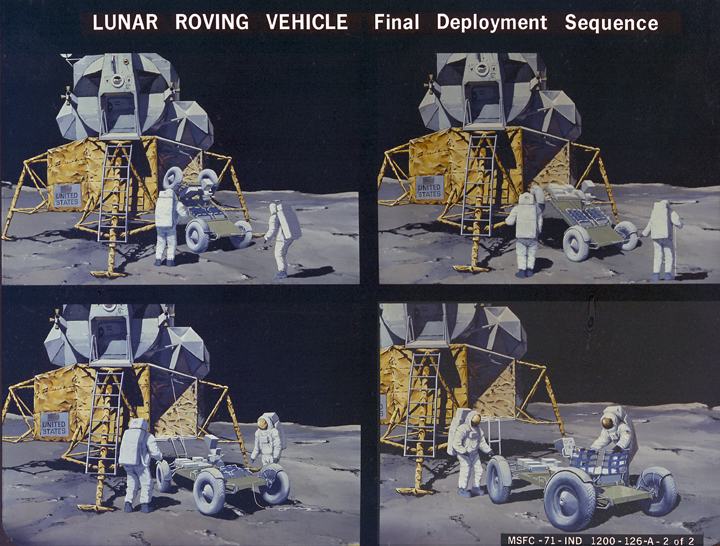

Moon Walk Hoax
in The Apollo Moon Landings
Posted
And Jack fails to honour his commitment - who would have seen that coming?
Oh yes, that's right - I did.